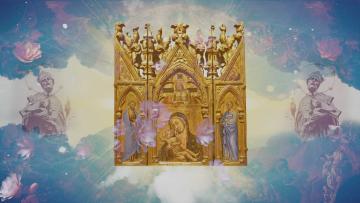Vesta Roman Goddess

Vesta Roman Goddess Facts
According to the Roman mythology, Vesta is etymologically equivalent to the Greek goddess Hestia. Vesta is the goddess of the home, hearth, and fire. Vesta was part of the main gods that were worshiped.
In Greece and Rome, people believed that goddesses ruled their world. With little entertainment, storytellers told adventures of these gods, the stories full of monsters, powers and above all trauma and tragedy. These gods were used to explain certain natural events and of course the beginning of life itself. A famous poet known as Homer recorded these stories which helps us understand what ancient Rome worshipped and operated through the stories of these wonderful gods and goddesses.
My name is Flo and I will reveal that many people in modern times don’t believe in goddesses like they used to, the story of Vesta has been passed down from the generations and with this the story has been distorted in many ways. I will reveal her story, in simple terms as many texts are complicated and will not miss out vital areas. Vesta was connected to the patroness of bakers and she was part of a religious ceremony and in ancient
Who was Vesta?
The Latin name of Cicero is where Vesta comes from In roman times families would spend the evenings around the fire together and they performed many rituals thanking the goddess Vesta for the warmth of the fire. She was rarely depicted in ancient times, and mostly, was just represented by a naked flame. Going back to ancient Rome, due to the unavailability of the source of fire in the early days, a lot of emphases was placed on the hearth fire, and it was both private and publicly maintained. Vesta was regarded as an important energy in every home. In astronomy, Vesta is a large asteroid which is 344 miles long.
What is the story and facts of Vesta the goddess?
Vesta the goddess gained popularity both during the Roman state and in homes through family worship. Every household made sure that she worshiped her near the fire hearth. Most household created shrines which had an image of the goddess Vesta. At every meal, an offering was made to the Vesta by throwing food into the fire.
If we think about the house we don’t often give it a thought. In life, we move through various houses, first our childhood house then maybe become a roommate to finally creating our own homes. Our first house is considered the womb. Turning to Carl Jung, he believed the home is certain vertical parts of our own psyche. The home and the comfort of the fire is our refuge. Vesta’e energy was known live between the burning of fire and the hearth, her goal as a goddess was to ensure that everything felt warm and cosy. In the Roman empire, every town and city kept a fire burning all the time, which was sacred for Vesta. Vesta was kept in a temple known as the “temple of Vesta,” which was situated in a Forum. She was taken care of by the Vestal virgins, who naturally turned out to be the priestesses. The temple of the Vesta comprised of very many legal documents for Rome. I will now briefly go over the story of Vesta which I am sure you will find interesting.
As I have already mentioned Vesta is the Roman goddess of fire, was revered in the Roman state and homes. Jupiter was her brother, I am sure you are aware of the planet Jupiter which was named after him. Jupiter was the god of the sky (the Greeks called him Zeus) he was a chief deity of Rome after defeating the Titans, he ascended to the throne of the gods on Olympus mountain. Jupiter was the god of the sky and ultimately the ruler. He offered Vesta the chance to have anything she wanted and her wish would be granted to her.
Vesta wished her virginity to be preserved. Apollo and Neptune asked for her hand in marriage when they saw her at Mount Olympus. She refused to get married and thus, her brother Jupiter allowed her to remain an eternal virgin as that was what she wished for. What a nice story!
In Roman mythology, why was Vesta significant?
According to the Romans, the goddess Vesta is portrayed as the deities which protect their empire and that, the fate and safety of the empire. It is believed that, as long as the sacred fire which burned in the temple of Vesta is burning, they are safe. And in case this got extinguished, then it spelled doom for the Romans and the empire at large. The fire in the temple burned up until 391 when Theodosius Empire banned public pagan worship.
Vesta was no longer a goddess of the hearth but light and the home. A festival was created in her honor during the summer solstice, it was apparent that the festival was an important event in the calendar. This occurred in the Roman calendar between the 7th to 15th of June which was officially named Vestalia holiday. A day when the Vesta was celebrated and the celebration involved women who walked barefooted heading to the temple of the goddess. Often, the Romans also worshipped was Lares and Penates in addition to Vesta.
During the state worship of the Vesta, everything was put into place so that it was a very elaborate celebration. In imitation of the round out of the Italian and symbolic symbol of a public hearth, the sanctuary of the goddess Vesta was traditionally circular. In the Roman forum, the temple of the Vesta underwent several rebuildings and restorations in both imperial and republican times. The perpetual fire of the hearth was burned in public, attended by the Vestal Virgins. The fire of the hearth was normally extinguished on March 1, which was originally the Roman, new year. The Romans believed that if this fire was extinguished prior to this either accidentally or otherwise, it meant a forthcoming disaster for Rome. The fire would need to be relit by lit from an auspicious tree, which was most probably a royal oak.
The sanctuary where the Vesta was kept remained private and only opened once a year, in the Vestalia period, between June 7th and 15th, a period when women visited this template barefooted. During the ceremony, the days were unlucky with the final day was dedicated to sweeping the building and disposing of the sweepings by throwing them in the Tiber or placing them in a special place along the Clivus Capitolinus; it is only when that is done that the period of bad luck ends. Atrium Vestae was the name which was originally given to the sacred area which comprised of a sacred grove, the Temple of Vesta, the Regia, which was the headquarters of the chief priests or Pontifex Maximus, and the House of the Vestals. But in simple terms, it was the palace of the Vestals.
How is Vesta artistically represented?
In drawings or art, the goddess Vesta is represented as an image of a woman with her favorite animal an ass. Being the hearth goddess, she was the patron deity of bakers. If you don’t know what the ass is, it is normally used to turn the millstone. It will be interesting also to note that, she was associated with the spirit of the baker’s oven, the Fornax. She was also an ally to Caca and Caucus, the primitive fire deities.
Why was Vesta the goddess of the home?
Vesta goddess was believed to have a special service for women, but at the same time, popular with both sexes. In some ancient artwork, she is at times shown holding a kettle which is a symbol of the hearth and cut flowers. From a symbol perspective, this denotes domesticity. It was believed that she was the protectress of Rome and maintained and cared for homes for every citizen.
What was the story about Vesta and the Vestal Virgins?
Basically the vestal virgins lived in buildings known as the Forum in the middle of Rome, these virgins gave them the scope to protect others, grant asylum and tending to the circular fire of Vesta. I will now move into more detail. The vestal virgins were real women who were selected between the age of 6-10 and had to remain virgins, and serve and worship Vesta, for 30 years. The vestal virgins were considered priestesses. In Ancient Rome, the vestal virgins were the only priestesses known at that time. What was the work of the vestal virgins? They were meant to make sure that, the sacred fire was always burning on the altar of Vesta, the goddess. They also made sure that a pledge, which was sacred and on which the existence and safety of the Rome depended on, was secure. After this time, they could get married but not many met partners.
They kept the perpetual fire going in Vesta’s template - and they had to prepare food for rituals and gain water from a well (as spring water had to be used) They would be beaten if they were not carrying out this work. These virgins were daughters of a family which were considered “noble” they decided to serve Vesta remained virgins and served Vesta but of course, because they were so young it was not a choice. They were forced to vow chastity and were treated with great honor. They lived in the Forum which was next door to Regia. In this forum the Vesta temple was circular. The vestal virgins swore a vow of chastity for 30 years, and if one of them broke this, they would be buried alive in the Field of Wickedness. Quite a stressful life, even writing this I feel sorry for them.
In Greek mythology who was Hestia (Vesta counterpart)?
Hestia is the same as Vesta. I know this all sounds confusing but basically, Roman gods and goddesses were taken from the Greek counterparts. Generally, the stories remain the same apart from the names in the research I have carried out.
I will briefly go over this story so you have the important names of the Greek counterparts. Hestia was the daughter of Rhea and Cronus. Like Vesta, she was known as a virgin goddess of architecture, the hearth and the right ordering of domesticity, the home, the state, and family. Like Vesta, she was one three goddesses who were virgins: Artemis, Athena, and Vesta. Seductive Apollo and Poseidon wanted to seduce her but she had made a vow with her brother Zeus (Jupiter in Rome) that she will always be pure and undefiled and thus, never to have any intimate relationship.
In the Greek world, her sisters were Hera, Zeus, Poseidon, Demeter, and Hades. And, her father Cronus. He was afraid that one of his children would dethrone him so he swallowed them apart from Zeus (Jupiter), and Hestia is the eldest, she was the first one to be swallowed. Zeus forced his father to disgorge his children, and Hestia was the last one to appear, thus making her be the youngest at the same time, the eldest daughter. Being the hearth goddess, she is the one who represented the burning fire in all the homes in Greece.
Every household in Greece made their first sacrifice to Hestia, where sweet wine was poured by families in her name, giving to her the richest food to her. The hearth fire was to burn throughout unless, by ritual, it was put off. Though she didn’t have any public cult-like she did in Roman mythology, Hestia was worshipped in all the temples, regardless of the god of the particular temple. According to Greek mythology, Hestia is portrayed as a kind, discreet and forgiving goddess with a non-confrontational and passive nature.
Who did Vesta marry?
Vesta never got married. She chose to remain a virgin and refused to get married to either Poseidon or Apollo, who were gods and who had an interest in her.
Conclusion:
From early times in Roman history there have been many archeology findings, they suggest that goddesses were worshiped and this is associated with ancient italic divinities. These included certain goddesses. Each village would have their own goddesses and the Roman goddesses come from predominantly Greek mythology.
By Florance Saul
Apr 22, 2018







